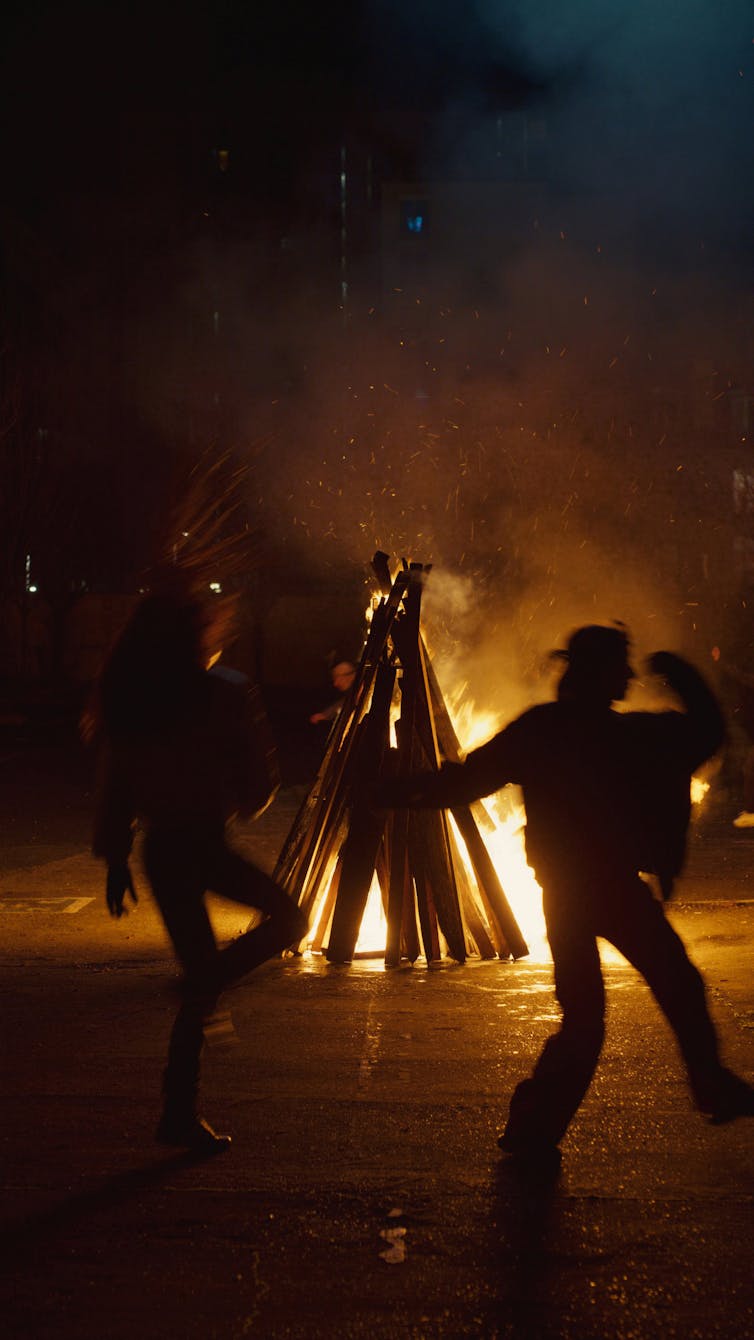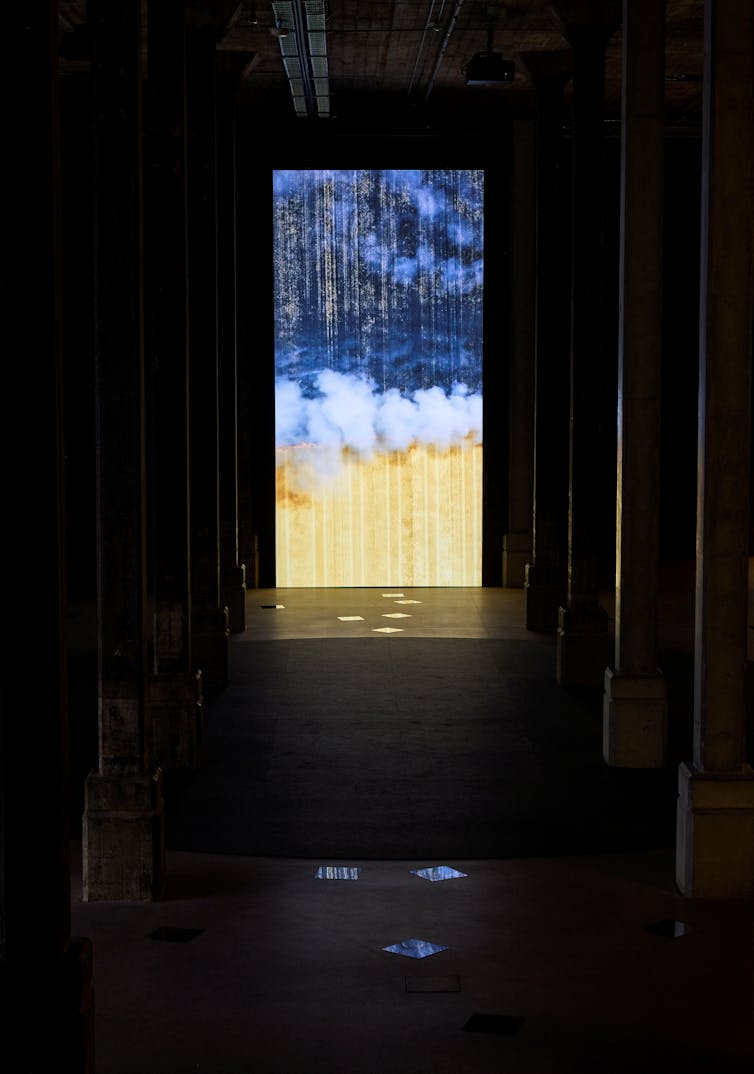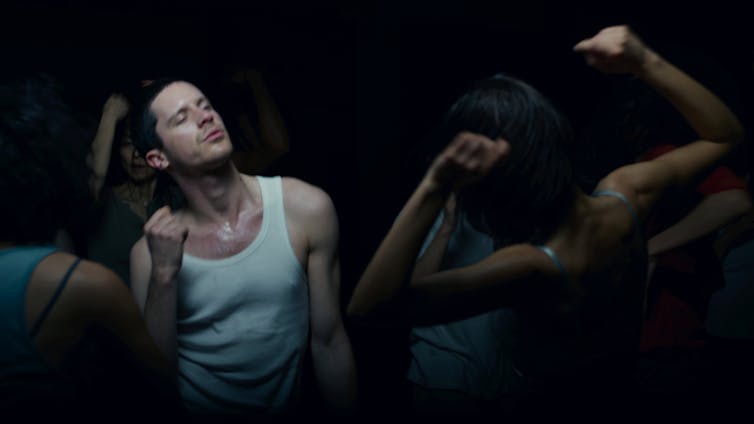The Nelson Packer Tank, that cavernous space at the very bottom of the Art Gallery of NSW’s Naala Badu building, has been waiting for art like this.
The former World War II oil storage tank is huge, held together by rows of structural columns. Their dominance means it is just not possible for viewers to have an unimpeded fields of vision for any art on display. Then there are the acoustics. Every sound resonates, but few carry far.
This is a room of echoes, embedded in the dark.
In this space Angelica Mesiti, an Australian living in France, has created The Rites of When: an event that rethinks ancient rituals of seasonal celebrations, while also marking the terrible changes wrought on our heating planet. Her tools are video, performers, music and song – all modified by the unique whispering echoes of the Tank.
The sky, and the snow
As the title implies, Mesiti has used the structure of Stravinski’s The rite of spring as one of the elements in her great design. But she shows a world far removed from mythical Russian peasants.
Each of the two movements are preceded by “Celestial Nebula”, where abstract forms of light dissolve into a vision of the night sky, presented on seven giant video screens.
This is not the sky as seen by city dwellers, where artificial light eliminates the stars, but rather the Milky Way in all its glory, with its hero stars which we call the Seven Sisters, but people in the northern hemisphere call the Pleiades.
© Angelica Mesiti, photo © Art Gallery of New South Wales, Jenni Carter
Mesiti has said one of her inspirations was that, when COVID came, she and her partner began to spend time away from Paris in rural France. Here she came to know the night sky, and to see both the rhythms and the realities of rural life.
In the first movement, a dazzling starscape is gradually bleached by artificial light, which transforms into sunlight, and the viewer is looking at drone footage of a snow-capped pine forest which we then zoom through.
The dominant columns of The Tank combine with the straight tree trunks of this plantation forest give a sense of visual ambiguity. With the all surrounding sound, it is hard to work out where the screened image ends and where the columns begin.

© Angelica Mesiti
A sudden shift of mood in the music, and the viewers are plunged into the middle of a Brueghel-like celebration of people dancing in the winter solstice. The colours are warm, the rustic dancers are wearing decorations made of the fruits of the field. They dance around a bonfire made from wooden planks, they form a procession with an effigy of a horned beast, stuffed with fireworks.
The fireworks and the dancers become a frenzy of ever increasing movement of rhythmic sound which explodes into dazzling white silence.
Capturing the summer solstice
When she was discussing The Rites of When at the media preview, Mesiti casually mentioned how hard it had been to film the snowy forest as, for the first time ever, winter was so mild it hardly snowed at all on the pine plantations of the Jura Mountains.
Global heating added an extra element when filming the summer solstice.
At first the viewer sees the seven screens as giant patterns of gold, marked by elegant patterns of vertical lines. Perspective changes when a tiny toy moving up one of the screens is revealed to be a harvester. This is a drone’s eye view of a wheat harvest in modern industrial scale farming. As the fields are slowly stripped of their crop, a puff of smoke appears, then a line of fire, and the gold is steadily eaten away to become charcoal.

© Angelica Mesiti, photo © Art Gallery of New South Wales, Jenni Carter
This was not planned. Europe was so hot and dry last June that a single spark from a harvester grinding a stray stone turned the wheat to ash. Monoculture, so effectively described by those endless flat golden fields, has no defence against nature.
The mood of the music changes and golden smoke covering the wheat dissolves into golden light. A small, solemn procession appears and moves across each screen in turn. They elevate each member in turn, in a quiet ritual performance.
The colours of the background change with their movement– from gold, to red, to purple, to blue. As they reach the last screen the blue fades to grey, to rain.
In the silence, a single hand on a single screen snaps fingers. On the other side of the room, another responds. Now there is a rhythmic orchestra clicking, clapping and slapping – ever faster, ever louder. The hands become dancers, moving in a wild ecstatic dance of increasing intensity, as the bodies are caught up with the music and the light.

© Angelica Mesiti
In her notes, Mesiti calls this section “Ecstatic Collectivity”. It seems an apt description.
At the very end, Mesiti returns us to the pure colours of the Celestial Nebula. Perhaps she is saying the folly of humanity may change the moods of the earth, but the stars will endure forever.
The Rites of When lasts just over 30 minutes. Because it is so dependent on its location, this is a piece that cannot travel. It is worth the price of an air fare.
The Rites of When is at the Art Gallery of New South Wales, Sydney, until May 11 2025.






